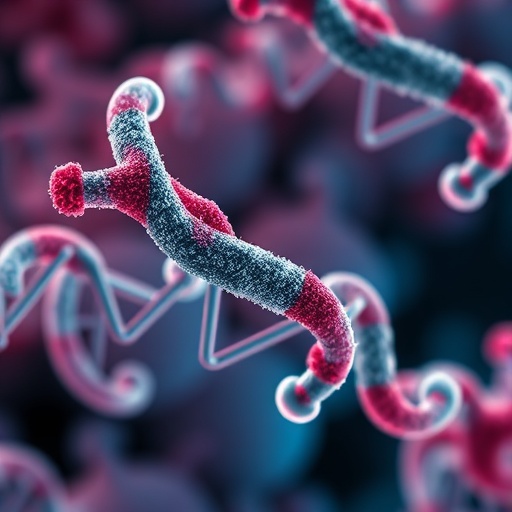In a groundbreaking advance for genome editing technology, researchers have engineered prime editors that dramatically reduce unintended genomic alterations, heralding a new era of precise genetic modification. This extraordinary leap holds vast implications for both fundamental research and therapeutic applications, paving the way for safer and more effective gene therapies.
Prime editing, a versatile method that enables targeted DNA alterations without introducing double-strand breaks, has emerged as a transformative tool in the field of genome engineering. However, off-target mutations and indel (insertion-deletion) errors have posed significant challenges, limiting its translational potential. The latest study addresses these hurdles head-on by designing improved prime editor variants optimized for fidelity and efficiency.
Mammalian cell cultures, including human embryonic kidney (HEK293T), lung cancer (A549), cervical cancer (HeLa) cells, and mouse embryonic stem cells, served as essential platforms for this pioneering research. These cells were maintained under rigorously controlled conditions to ensure reproducibility and reliability of the functional assays. The use of both human and mouse models underscores the broad applicability of the engineered prime editors across diverse biological systems.
The innovative engineering process involved meticulous mutagenesis and cloning of Cas9-based prime editors, utilizing state-of-the-art molecular biology techniques. Researchers harnessed PCR-driven splicing and Golden Gate cloning methods to precisely introduce single-residue and combination mutations into the prime editor sequences. These strategic modifications refined the molecular architecture of prime editors, striking an optimal balance between editing precision and enzymatic activity.
Structural analysis using high-resolution crystal structures of Cas9 in complex with DNA substrates provided critical insights into the spatial configuration of the engineered editors. Leveraging PyMOL visualization, the team identified key noncanonical interactions and conformational dynamics that influence editing outcomes. These structural cues guided the rational design of enhanced prime editor variants, minimizing erroneous DNA nicking and subsequent mutagenic events.
Cell transfection protocols were meticulously optimized to maximize delivery efficiency and editing consistency. Employing Lipofectamine 2000-mediated transfections in 48-well culture plates, DNA vectors encoding different prime editor variants and their corresponding pegRNAs were carefully formulated. Genomic DNA extraction timelines and flow cytometry-based assessments were calibrated to capture precise editing kinetics and phenotypic changes over extended culture periods, enhancing the quantitative robustness of the study.
High-throughput sequencing, coupled with sophisticated bioinformatics pipelines like CRISPResso2, enabled comprehensive profiling of editing efficiencies, indel frequencies, and off-target effects at unprecedented resolution. By finely tuning parameters to distinguish between prime-edited alleles and undesired mutations, this approach uncovered subtle yet critical differences among the various prime editor designs. The data underscored the superiority of the engineered variants in achieving high fidelity edits with minimal collateral damage.
Beyond sequence-level analysis, the researchers probed cellular DNA repair mechanisms and nicking dynamics by analyzing dual-guide RNA-induced cleavage patterns at endogenous genomic loci. This sophisticated assessment revealed the frequency and positional shifts of DNA nicks, providing valuable insights into the molecular underpinnings of prime editor specificity. The quantification of nicked end degradation further illuminated the pathways contributing to error suppression in the newly developed editors.
A comprehensive evaluation of off-target editing across multiple established loci demonstrated remarkable reductions in unintended genomic alterations. The engineered prime editors consistently outperformed standard versions in discriminating between on-target and off-target sequences, a critical feature for clinical consideration. These findings substantially mitigate concerns surrounding off-target mutagenesis that have historically shadowed CRISPR-based technologies.
Importantly, the research incorporated robust statistical analyses, including unpaired two-tailed Student’s t-tests and Pearson correlations, to validate the reproducibility and significance of the observed enhancements. Error bars representing standard errors from independent replicates provided transparency and confidence in the conclusions drawn. This rigorous quantitative framework lends substantial weight to the transformative potential of the engineered prime editors.
The implications of these findings for therapeutic gene editing are profound. With reduced risk of harmful genomic errors, these enhanced prime editors bring us closer to realizing precision medicine strategies targeting a myriad of genetic diseases. By fine-tuning molecular components and leveraging structural insights, the study exemplifies how synthetic biology can surmount longstanding barriers in genome editing safety.
This breakthrough also propels the field toward more nuanced control of DNA repair processes, opening avenues for bespoke genetic interventions. Future work may build upon these engineered platforms to extend the scope of prime editing to more complex genomic rearrangements and epigenetic modifications, broadening the landscape for biomedical innovation.
In sum, the development of prime editors with minimal genomic errors represents a critical milestone in genome engineering. By integrating molecular design, structural biology, advanced sequencing, and computational analysis, the research delivers a compelling blueprint for creating safer and more effective gene-editing tools. As this technology matures, it promises to catalyze transformative advancements in research and therapy alike, embodying the next frontier of genetic medicine.
Subject of Research: Engineered prime editors for precise genome editing with minimal genomic errors.
Article Title: Engineered prime editors with minimal genomic errors.
Article References:
Chauhan, V.P., Sharp, P.A. & Langer, R. Engineered prime editors with minimal genomic errors. Nature (2025). https://doi.org/10.1038/s41586-025-09537-3
Image Credits: AI Generated
Tags: Cas9-based prime editorsengineered prime editorsfunctional assays in genetic researchgenome editing technologyinsertion-deletion errorsmammalian cell culturesmolecular biology techniquesoff-target mutationsprecise genetic modificationtargeted DNA alterationstherapeutic gene therapiesunintended genomic alterations





